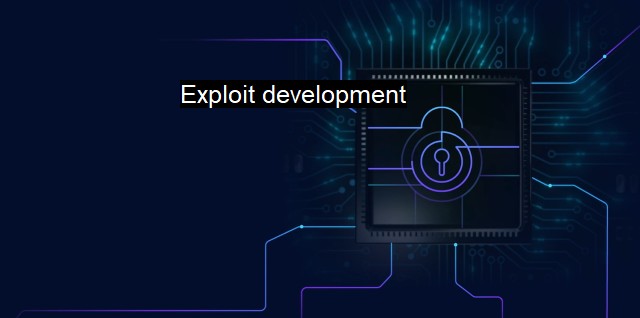What is Exploit development?
Exploring the art and science of exploit development: understanding vulnerability exploitation and its impact on cyber security
Exploit Development constitutes a significant segment of cybersecurity practices that focuses predominantly on identifying, assessing, and contriving farming strategies to exploit vulnerabilities in software applications or networks. It encompasses the methodologies and procedures employed by cybersecurity experts to expose potential security shortcomings render appropriate solutions in regard to cyber threats — by exploiting the same vulnerabilities. Professionals adept in exploit development possess comprehensive knowledge of advanced computing, programming, reverse engineering and cryptography.Foremost, comprehend precisely what an exploit is here. In the computer landscape, an exploit is a piece of software, a chunk of data, or a command sequence that seeks out system vulnerabilities to breach its security parameters. As the name suggests, an exploit "exploits" software or hardware weaknesses to gain unauthorized access, causing unintended and potentially damaging consequences to compromised systems. Cybercriminals leverage these exploits to propagate harmful activities like unauthorized intrusions, data breaches, system crashes, Denial of Service attacks, or the introduction of malware.
Consequently, Exploit development stems from the need to protect companies and individuals against the negative impact of such activities. It follows a systematic process that arms cybersecurity experts with profound insights into fortifying software systems or network defenses, albeit the complexity of the distributed IT ecosystems.
The initial step towards exploit development strongly resonates with the concept of penetration testing. It involves the identification of potential vulnerabilities in a given system using tools like debuggers and fuzzing software. It's followed closely by validating the threat intensity of these vulnerabilities through a proof-of-concept exploit.
The efficiency of the proof-of-concept exploit outlines the need for reverse engineering. Reverse engineering involves breaking down software components to understand their architecture, functions, and identify potential weak links. Knowledge of assembly language and reverse engineering tools is indispensable for decoding machine-level software applications' functions and debugging assembly language instructions that developers use in exploit development.
The phase of planning and exploitation development subsequently sets in, where cybersecurity professionals retrieve input data prone to manipulation and premeditate the exploit against that data. Buffer overflow serves as a conspicuous example of such input data and malware writing aimed towards its modification. Later, in-memory payload is created, intending to perform explicit and intended actions upon successful operation.
The final phase involves delivery and testing, where developers subtly introduce the exploit in the concerned system replicating real-life scenarios of cyber breaches. An inspection of the test's efficiency follows through, halting when one achieves the absolute exploit condition and repeating if necessary.
Exploit development no more remains confined to a contingency plan rather has grown extensively into an anticipatory defense strategy. Antivirus companies dwelled into exploit development spotlight early. They now spend a significant share of turnover to maintain teams of professionals specializing in exploit development. These professionals exhibit prowess in evaluating vulnerabilities and developing exploits for newly found threats continually. It aids software developers towards rolling subsequent versions of the software, making it much immune to exploitation.
In comprehensive consideration, exploit development emerges as an indispensable process in the cybersecurity blueprint's pretense, holding antivirus measures paramount. The projected futuristic collaborative practices of sharing threat intelligence, and accelerated global cybersecurity initiatives are directing exploit development towards a solicitous systemic avenue authorized to dismantle malicious activities scientifically. it leverages radical robustness against prospective and present security threats and helps preserve the integrity of technological resources.

Exploit development FAQs
What is exploit development?
Exploit development is the process of creating or discovering security vulnerabilities in software and developing techniques to exploit them for unauthorized access or control of a target system.Why is exploit development important in cybersecurity?
Exploit development plays a crucial role in cybersecurity as it helps identify and remediate software vulnerabilities, preventing cybercriminals from exploiting them to gain unauthorized access or cause damage to systems.What is the relationship between exploit development and antivirus software?
Exploit development and antivirus software are closely related as antivirus systems use signature-based and behavior-based detection methods to identify known and unknown exploits. Exploit developers use various techniques to evade antivirus detection, and antivirus software vendors update their systems regularly to detect these new techniques.Is exploit development illegal?
Exploit development itself is not illegal, but using these techniques to gain unauthorized access or control of systems, or to cause damage, is illegal and can result in serious consequences. Ethical hackers and cybersecurity professionals use exploit development techniques to identify and remediate software vulnerabilities for the betterment of cybersecurity, but they do so within the confines of legal and ethical boundaries.| | A | | | B | | | C | | | D | | | E | | | F | | | G | | | H | | | I | | | J | | | K | | | L | | | M | |
| | N | | | O | | | P | | | Q | | | R | | | S | | | T | | | U | | | V | | | W | | | X | | | Y | | | Z | |
| | 1 | | | 2 | | | 3 | | | 4 | | | 7 | | | 8 | | |||||||